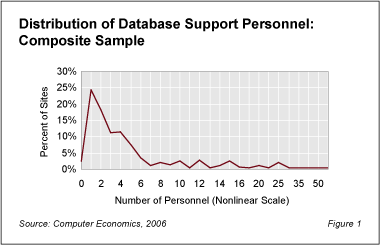As most CIOs recognize, the amount of information managed within databases is increasing greatly each year. There are two key reasons for this increase. First, regulatory requirements, such as Sarbanes-Oxley and HIPAA, have increased data retention requirements. With disk storage costs dropping annually, most companies find it easier to simply increase the size of databases rather than question why so much data needs to be retained.
Second, as companies continue to digitize all aspects of the business, the number of databases that need to be administered increases. For example, in many manufacturing firms today, there are programs underway to digitize all product data, much of which were formerly paper-based. In healthcare organizations, there are major efforts underway to digitize patient records. In nearly every industry, the conversion from paper to electronic media continues apace.
These two trends–increasing the size of databases and increasing the number of databases–makes database administration and support a critical function in nearly every IT organization. But while IT managers generally recognize the importance of these databases to their companies, they may sometimes question the costs and staffing required to maintain an effective database infrastructure. How many personnel should be dedicated to database administration and support for a company of our size? What is the typical ratio of database support staff to the total IT staff? How many headcount do other IT organizations dedicate to database staffing? What are the economic returns for database software? The full version of this report provides benchmarks to answer these questions.
Surveys conducted by Computer Economics in 2004 and 2005 provide insights into the costs and staffing levels required to maintain database infrastructure. The participants in these surveys included approximately 275 CIOs and senior IT managers from companies of varying sizes across the US and Canada. The resulting data provides benchmarks for comparing the staffing ratios in your company against norms in other companies of the same size. The question of how economical databases are to operate and the reliability of budgetary projections were also investigated, from several perspectives. Recommendations are also provided, based on our analysis, for more effective management of the database infrastructure.
Staffing Ratios
As one would expect, our research shows that the size of the business greatly influences the number of database administrator and support staff required. Figure 1 shows the composite distribution of database personnel. The horizontal axis lists the number of database support personnel. Note that the scale of this axis is not linear but is compressed on the right side. This allows more detail to be shown for cases with less than 20 database support personnel, because these are the most frequently occurring situations. The vertical scale shows the percent of the sites with each number of database employees.

The composite data shows that predominantly fewer than eight database staff members are required for database administration and support. Study results further show that only two percent of the data centers do not have dedicated database support staff. Most frequently, only one person performs all of the database work, but some organizations require 40 or more people to handle these functions. The average size of database support staff was 6.7. However, keep in mind that these statistics represent organizations of all sizes combined.
The full version of this report provides a breakdown of database staffing trends by organizational size, which are more useful in benchmarking a particular company. The breakout by organizational size is as follows:
- Small organizations: Annual revenues less than $250 million
- Medium organizations: Annual revenues between $250 million and $750 million
- Large organizations: Annual revenues in excess of $750 million
The full version of this report also provides the following detailed metrics for database staffing:
- Database staffing on a percentile basis, showing the 25th, median, and 75th percentiles by company size.
- The average database support personnel headcount as a percentage of total IT staff, by company size.
- Percentage of companies reporting full return on investment (ROI) for database software.
- Percentage of companies reporting total cost of ownership (TCO) less than or equal to budget.
The full version of this report provides guidance on how to analyze causes of deviation from the staffing benchmarks and strategies for improving the ROI and TCO of database software.
January, 2006
This Research Byte is a brief overview of our report on this subject, Database Staffing Benchmarks. The full report, is available at no charge for Computer Economics clients, or it may be purchased by non-clients directly from our website at https://avasant.com/report/database-staffing-benchmarks-2006/.



